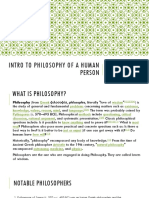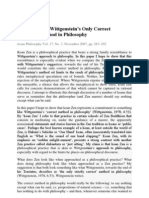Joseph Waligore - Indian Influence On Greeks
Joseph Waligore - Indian Influence On Greeks
Uploaded by
Julia BlackwolfCopyright:
Available Formats
Joseph Waligore - Indian Influence On Greeks
Joseph Waligore - Indian Influence On Greeks
Uploaded by
Julia BlackwolfOriginal Description:
Original Title
Copyright
Available Formats
Share this document
Did you find this document useful?
Is this content inappropriate?
Copyright:
Available Formats
Joseph Waligore - Indian Influence On Greeks
Joseph Waligore - Indian Influence On Greeks
Uploaded by
Julia BlackwolfCopyright:
Available Formats
Indian Influence on Greeks
Indian influence on Hellenistic Philosophy Pyrrho is the founding figure in Greek skepticism. An ongoing debate within Hellenistic philosophy is whether Pyrrhos skepticism and the doctrine that the sage is imperturbable is indigenous to Greek philosophical tradition or whether it was substantially influenced by Indian philosophy. The impetus for this discussion is the description of Pyrrhos life in Diogenes Laertius (IX.61) which describes the influence of the Indian gymnosophists- naked philosophers- on Pyrrho. For Diogenes states that Pyrrho got the idea of agnosticism and the suspension of judgement from his trip to India. John Burnet was one of the first to advance the position that Pyrrho was strongly influenced by Indian philosophy: We see that those who knew Pyrrho well describe him as a sort of Buddhist arhat [enlightened monk] and that is doubtless how we should regard him. He is not so much a skeptic as an ascetic and quietist.[1] Many other Greek scholars have agreed with this position. This is of course based on taking Diogenes Laertius biography of Pyrrho as basically accurate. Flintoff in a Phronesis article gives the best defense of Diogenes biography of Pyrrho: In his carefully and precisely documented life of Pyrrho of Elis, a life which is certainly one of the best such in the Lives of the Eminent Philosophers and draws upon an impressive gamut of different and seemingly independent sources (some of them, like Antigonus of Carystus, IX 62), near contemporaries of the subject of the biography, Diogenes is giving us an accurate account of Pyrrhos life.[2] While not all scholars agree there is Indian influence on Pyrrho, it is significant that in the debate they do not question the basic biography that Diogenes offers of Pyrrho, they only question whether Indian influence is the best way of explaining Pyrrhos philosophy and way of life. Reale advanced the thesis that the doctrine the sage is happy even while being tortured became prominent in Hellenistic philosophy because of the meeting of Pyrrho with Indian philosophers on his trip to India with Alexander the Great. Reale claims that in Pyrrho there is a new type of person entering Greek culture and this new type of person flowers in the Stoics and Epicureans who were influenced by Pyrrho.[3] Before examining Reales thesis, I will relate the information of the general Greek contact with Indian philosophers which is contained in Strabos Geography, Plutarchs Life of Alexander and Arrians Anabasis of Alexander. Pyrrho traveled with Alexander the Greats army to India and while he was there he encountered the gymnosophists, or naked philosophers. These naked philosophers, probably Jain monks, taught a doctrine of total indifference to bodily concerns. These monks
disregarded their body and would meditate naked all day in the blazing sunshine. Onesicritus, a disciple of Diogenes the Cynic, was also on this trip and he visited the gymnosophists. He saw them on the hot sand, motionless, devoted to endurance. Onesicritus said the sand was so hot that no one could endure walking on it with bare feet. Nevertheless, these naked monks stood or laid motionless on the sand for the whole day.[4] Their primary teaching was that a person ought to remove pleasure and pain from the soul.[5] One of these monks, Calanus, made a very strong impression on the Greeks. For Alexander the Great wanted some of these Indians monks to travel with him so that he could talk with them. Most of the monks refused, saying that Alexander had nothing that he could offer them.[6] Nevertheless, one monk, Calanus, decided to travel with Alexander the Great and his army. Interestingly, Calanus was teased by the other monks for specially lacking self-control; they reproached Calanus because he deserted the happiness to be found with them and served a master other than God.[7] While he was traveling with Alexanders army, Calanus realized that he had an incurable stomach ailment and rather than be an invalid, he decided to kill himself.[8] Alexander and the Greeks tried to dissuade him, but Calanus was determined to commit suicide. A big funeral pyre was built and Calanus climbed on it amongst much fanfare in the Greek camp.[9] As he set himself on fire and burnt to death, Calanus was totally imperturbable; the seemingly unbearable pain did not phase him at all.[10] The Greeks were amazed at this total self-control; they were astonished to see that Calanus did not move any part of his body in the flames.[11] This showed them how strong and invincible human resolution really was.[12] Pyrrho saw Calanus burning and was struck by the monk being burnt alive with total imperturbability. To Pyrrho, this demonstrated that external events are not intrinsically painful as the sage can neutralize even the worst suffering. This was proof to Pyrrho that if you were mentally strong enough, nothing external could affect you and thus it was indeed possible for a sage to be totally impervious to pain.[13] Pyrrho saw in this a living demonstration that the sage can be happy even in the midst of the worst torment.[14] Reale and others maintain that because of seeing Calanus impervious to pain, Pyrrho came back to Greece knowing the practicality of a lifestyle of invulnerability to the external world. This notion of the sages invulnerability may have been a theoretical ideal in Greek philosophy before Pyrrho, but now it became practical in a whole new way. According to Reale, Pyrrho envisioned a new type of man for the Greeks.[15] From Pyrrho, this doctrine passed to Epicurus and the Stoics. For the founders of both schools were very much interested in Pyrrho. Nausiphanes was captivated by Pyrrho and when Epicurus met Nausiphanes, Epicurus marvelled at Pyrrho and
continually asked Nausiphanes about Pyrrho.[16] Furthermore, the founder of Stoicism was very much influenced by the new type of man that Pyrrho introduced into Greek thought.[17] Possible Greek sources of Pyrrhos philosophy Reale is right and Pyrrho was influenced by the Indian philosophers. The problem though was that Pyrrho did not learn enough from the Indians and this accounts for the inadequacies of Stoic ethical theory. Before I investigate this point, I need to defend Reales thesis from the criticism that Pyrrhos philosophy could have developed from the internal dynamics of Greek philosophy. There are three important possible sources from within Greek philosophy for the Pyrrhos philosophy: Socrates, Democritus and the Cynics. In defending Reales thesis it is important to remember Reale and others are not claiming that the Greeks did not have a intellectual conception of the sages invulnerability, they are only claiming that a new type of person was introduced into Greek culture because of Pyrrhos encounter with Indian gymnosophists. Socrates is the first possible source within Greek philosophy for the later Hellenistic concern over the sages total imperturbability. Certainly Socrates maintained that virtue was very much related to happiness and he was legendary for his powers of physical endurance. Furthermore, in the Apology (30C) Socrates says that Meletus and Anytus could not harm him and he also says no evil can happen to a good man.(41C-D) This is certainly the intellectual foundation for the idea that the good man cannot be harmed even if he is tortured. Furthermore, Socrates was evidently not perturbed about dying and so he lived this ideal to some extent. Nevertheless, in the Crito (47E) Socrates asks: Then is life worth living when the body is worthless and ruined? Crito responds: Certainly not. Socrates then goes on to maintain that the health of the soul is even more important than the health of body. This argument has no force unless Socrates thinks the bodys health is important. There is also a discussion of health in the Lysis (218E) where Socrates implies that health is a good thing. Furthermore, Socrates says that it is better to suffer wrong than to do it, although he wishes not to do either.(Gorgias, 469C) This implies that even a sage could suffer a wrong and later on Socrates reinforces this by saying that a man put to death unjustly is wretched, although not as wretched as the person who puts him to death.(Gorgias, 469B) Socrates position on the relationship between virtue and happiness has recently been a very controversial issue.[18] There is significant evidence that Socrates identified virtue and happiness, while there is also much evidence that shows that Socrates thought non-moral goods such as health contributed to ones happines s.[19] The best position on this difficult issue is taken by Klosko.[20] For Klosko maintains that
Socrates holds two different positions regarding the relationship between virtue, other goods, and happiness in different kinds of situations.[21] Thus in matters of life and death, as in the Apology and Crito, Socrates has a tendency to advocate the view that identifies virtue with happiness.[22] However, when Socrates is concerned with more general ethical matters, he has a tendency to espouse the wider view that other, nonmoral goods contribute to happiness.[23] So Klosko correctly locates Socrates in between Stoics who identify virtue with happiness and the more common position that external goods are necessary for happiness. We cannot conclusively know Socrates opinions on this subject, but there is a much different tone in Socrates from the later Hellenistic philosophers. Socrates loved life and had nothing against enjoyment and pleasures as long as they did not prevent someone from being concerned about virtue; he has a much different outlook than the Hellenistic philosophers who maintain the sage even welcomes torture to prove himself. The Hellenistic emphasis on bearing torture and indifference to pain is much closer to the Jain monks than it is to Socrates. Socrates certainly contributes to the Greek receptivity to the Indian philosophers, but Socrates is not enough to explain the new, much more austere way of living that Pyrrho and other Hellenistic philosophers embrace. While Socrates is not enough to explain Pyrrhos new way of living, McEvilley offers Democritus as the Greek source for Pyrrhos philosophy.[24] McEvilley offers as evidence first that Pyrrho was taught by Anaxarchus who was a pupil of Democritus or of a Democritean.[25] Furthermore, Democritus extols tranquility which is a state in which the soul continues calm and strong, undisturbed by any fear or superstition or any other emotion.[26] McEvilley also tries to show that one can derive the skeptical elements of Pyrrhos thought from Democritus philosophy.[27] Nevertheless, within McEvilleys very defense of Democritus as the source of Pyrrhos thought, he gives much more evidence of Indian influence on Pyrrho than of Democritus influence. McEvilley points out so many similarities between Pyrrho and Buddhism that he himself destroys his very position. Most importantly of all, there is the fundamental difference between Pyrrhos general philosophical system and Democritus system. Democritus had a dogmatic ontology with atoms being the basis of reality, while Pyrrho adopts a total skepticism. On the other hand, skepticism at this time was rampant among the Indian philosophers. Furthermore, the purpose of Indian skepticism was to achieve tranquility which is exactly the same goal as in Pyrrhos ethics.[28] So at the core of Pyrrhos philosophy is exactly the same position as Indian philosophy, a position which Democritus does not share. Even McEvilley sees that Pyrrhos position here is much closer to Buddhism than to Democritus: Pyrrhon omitted the dogmatic atomism and retained the phenomenalism as Buddhism positively negated ontology and took to phenomenalism.[29] So like Buddhism, and unlike Democritus, Pyrrhos
philosophy fundamentally negated ontology and adopted phenomenalism according to McEvilley. Another commentator thinks Buddhism and Pyrrhos philosophy are so close that Pyrrho might have adopted the very words of the Buddhists.[30] McEvilley further destroys his position by listing many more similarities between Buddhism and Pyrrho than he does between Democritus and Pyrrho. Indeed his own list of similarities between Buddhism and Pyrrho include all of Pyrrhos major positions: things are nondifferent (adiaphora) or without distinguishing marks, things are without a definite essence, our opinions are neither true nor false, we should be without judgments and preferences, this lack of opinions leads to imperturbability, moderation, various mind states are flows of sense impressions which we should accept with equanimity, and getting beyond conceptualizing leads to aphasia and to ataraxia.[31] All these positions are the basis of Buddhism as well as Pyrrhos philosophy. McEvilley even states that the essence of Buddhist philosophy, the Four Noble Truths, are more or less identical with the main thrust of Pyrrhos basic philosophy or Pyrrhos basic philosophy might function as an explication of the Four Truths.[32] While he does list all the Buddhist similarities to the most important of Pyrrhos doctrines, even McEvilley does not claim that all these doctrines are similar to Democritus positions. So McEvilley himself better demonstrates Indian, especially Buddhist, influence on Pyrrho rather than Democritus influence. Nor is this the only problem with McEvilleys position. Flintoff further catalogues the practical ways of living that are unique to Pyrrho and unknown in previous Greek tradition: the transcendence of pain, his lack of involvement with the political and practical affairs of the city states and his vagrancy.[33] While these are all unprecedented in Greek thought, (except for maybe Heraclitus), they are all common features of Indian ascetical life. There are two more major problems of trying to show Democritus influence on Pyrrho. First, there is no evidence from his writings or his life that Democritus practiced the kind of indifference that Pyrrho practiced. Nor is there any evidence Democritus maintained the extreme position that the sage can be happy while being tortured or indeed anything close to that position. So there is no evidence that Democritus contributed anything more than Socrates and so at most he helped lay the conceptual foundation of a doctrine that Pyrrho found actually lived in India by the gymnosophists. The last problem for McEvilleys positions is that even if Pyrrho was influenced by Democritus, it still would not give conclusive evidence that this doctrine comes from sources purely internal to Greek philosophy. For Diogenes Laertius relates that Democritus traveled to India to study with the gymnosophists[34] and thus even if Democritus had this practical philosophy of invulnerability, he could have gotten it
from Indian philosophy. Flintoff shows that there is no reason not to believe these stories in Diogenes as they are not mechanically told and the Greeks often learnt from other countries in other areas.[35] Furthermore there is one story in Diogenes Laertius about Democritus doing ascetical exercises that could best be explained by Buddhist influence. Diogenes relates that Democritus would train himself, says Antisthenes, by a variety of means to test his sense-impressions by going at times into solitude and frequenting tombs.[36] While there is no evidence of frequenting tombs in Greek tradition as a way of training ones sense impressions, the Buddhists had a quite intricate and gruesome meditation system based on dead bodies and visiting tombs.[37] Democritus exercises are better explained by saying that he learnt them from the Buddhists, than that he developed them himself. So the evidence for Democrituss influence on Pyrrho does not withstand critical inquiry. The last possible source for Pyrrhos way of living internal to Greek philosophy is the most credible source: the Cynics. This Greek philosophical school advocated an indifference to social customs and freedom from society before Pyrrho ever went to India. Furthermore, the Cynics wanted to be free from pleasure and indifferent to pain. There are also stories in Diogenes Laertius of the austerities Diogenes performed in order to become indifferent to pain. In summer he used to roll in it over hot sand, while in winter he used to embrace statues covered with snow, using every means of inuring himself to hardship.[38] While it seems the Cynics believed in asceticism, nevertheless there is a major problem with the stories about the Cynics. For it turns out that rather than this asceticism being indigenous to Greek philosophy, many of the stories about the Cynics indifference to pain were later literary inventions so that the Cynics could match the Indian gymnosophists. Ragnar Hoistad shows that these stories about Diogenes ascetical ability were copied from Onesicritus description of the gymnosophists.[39] Onesicritus was a disciple of Diogenes who accompanied Alexander to India and he was very interested in the gymnosophists. Nevertheless Onesicritus found in the gymnosophists a much more radical type of asceticism than the Cynics practiced.[40] Gerhard, in an important study of the legend of Diogenes, shows that as Indian influence came into Greece at the time of Alexander, this created a desire to portray Diogenes as being a match for the Indian gymnosophists.[41] Thus the Greeks wanted to see the Cynics as practicing asceticism as rigorously as the Indians practiced it. So the story of Diogenes rolling in the hot sand seems to be copied from Onesicritus account of Indian philosophers lying naked on the hot rocks and sand.[42] Evidence shows that the stories about Diogenes asceticism were specifically invented so that the Cynics could match the kind of indifference the Indians were able to practice. This evidence makes it doubtful the Cynics really were able to be indifferent and imperturbable. Thus it is unlikely their influence was enough to
generate Pyrrhos new way of life. More likely the Cynics, like Socrates, contributed an ideal for a way of life that made Pyrrho receptive to the Indian philosophers. Thus the Indian gymnosophists were living proof to Pyrrho that the Cynic ideal could be fully practiced in all ones life.[43] The evidence for Indian influence on Pyrrho and so on the Hellenistic doctrine that the sage can be happy even if tortured is strong but not conclusive. While parts of this doctrine were held by Socrates and the Cynics, Pyrrho takes the doctrine to a radically deeper level because of Indian influence. This conclusion is strengthened if one also looks at the deep similarity between Indian logic and skepticism and Pyrrhos logic and skepticism.[44] Because of the deficiencies of the historical record, the Indian influence on Hellenistic thought cannot be established conclusively. Nevertheless this influence would explain the deficiencies in Stoic thought. For while the Greeks borrowed from Indian philosophy, they only had limited contact with the Indians and could not penetrate to the core of Indian thought. So Pyrrho could see Calanus burning and be inspired by that to believe a person actually could be totally indifferent to whatever happened to him, but he was not able to discover the deeper system behind Calanus actions. It is relatively easy to watch someone immolate himself and draw the idea that one can be indifferent to all that happens; it is much harder to really understand everything behind that action. Pyrrho especially could easily have missed the vital importance of meditation in Indian thought. For meditation is not something a person can master in a short while. To learn how to meditate well, one needs a teacher and long experience, especially if one wants to master the higher levels of meditation. A similar point could be made about the happiness that comes from meditation and becoming concerned for the whole. So Pyrrho was inspired by the Indian philosophers because the Indians perfected Greek philosophical ideals, but he missed the point that meditation was necessary to fully live this life. So it is very likely that Pyrrho was inspired by Indian philosophy, but did not learn about meditation or about the happiness that comes from being concerned for the whole. For this reason, the Stoics also would be lacking these features in their ethical system. The sense there was something more to be learnt from India was felt by later Greek philosophers. Thus the Neopythagorean philosopher Apollonius of Tyana went to India to learn from the Indian philosophers. Even more importantly, Plotinus tried to go to India and learn more from the Indian philosophers. For Plotinus accompanied the Roman emperors army on an expedition to India but dis aster struck the expedition and both the army and Plotinus never made it to India.
[1]. John Burnet, Encyclopedia of Religions and Ethics, Vol. 11, (no date or place given), p. 229, as quoted in Everard Flintoff, Pyrrho and India, Phronesis 25 (1980): 108. [2]. Flintoff, 88. [3]. Giovani Reale, History of Greek Philosophy, Vol. 3 (Albany: SUNY Press, 1985), 311-327. [4]. Strabo Geography 15.1.63. [5]. Strabo 15.1.65. [6]. Arrian Anabasis of Alexander 7.2. [7]. Arrian 7.2. [8]. Arrian 7.3 and Plutarchs Lives, Vol. VII, Cambridge: Harvard University Press, 1971, p. 417. [9]. Arrian 7.3. [10]. Plutarch, Lives, pp. 417-9. [11]. Arrian 7.3. [12]. Ibid. [13]. Reale, Vol. 3, 311. [14]. Reale, Vol. 3, 312. [15]. Reale, Vol. 3, 325. [16]. Diogenes Laertius 9.64. [17]. Reale, Vol. 3, 325-6. [18]. See the Vlastos and Irwin articles cited in the next footnote.
[19]. The best discussion of the evidence is in Gregory Vlastos, Happiness and Virtue in Socrates Moral Theory,in Socrates: Ironist and Moral Philosopher (Ithaca: Cornell University Press, 1991) and T. H. Irwin, Socrates the Epicurean? Essays on the Philosophy of Socrates, ed. Hugh Benson (New York: Oxford University Press, 1992). [20]. G. Klosko, Socrates on Goods and Happiness, History of Philosophy Quarterly 4 (1987). [21]. Klosko, 260. [22]. Klosko, 259. [23]. Klosko, 260. [24]. Thomas McEvilley, Pyrrhonism and Madhayamika, Philosophy East and West 32 (January 1982): 19-22. [25]. Diogenes Laertius 9.58. [26]. Diogenes Laertius 9.45. [27]. McEvilley, 21-5. [28]. Flintoff, 93. [29]. McEvilley, 21. [30]. Bhikku Nanajivako, The Indian Origin of Pyrrhos Philosophy of Epoche, Indian Philosophical Quarterly 12 (Oct-Dec. 1985): 320. [31]. McEvilley, 3-4. [32]. McEvilley, 17. [33]. Flintoff, 98-9. [34]. Diogenes Laertius 9.35. [35]. Flinthoff, 89-90.
[36]. Diogenes Laertius 9.38. [37]. The best description of this Buddhist practice is in Bhadantacariya Buddhaghosa, The Path of Purification, Vol. 1 (Boulder: Shambhala, 1976), p. 185-9. [38]. Diogenes Laertius 6.23. [39]. Ragnar Hoistad, Cynic Hero and Cynic King (Uppsala: Carl Bloms Boktryckeri, 1948), 137-8. [40]. Hoistad, 137. [41]. G.A. Gerhard, Zur Legende vom Kyniker Diogenes, Archiv fur Religionswissenschaft 15 (1912): 394f. as cited in Hoistad, 138. [42]. Hoistad, 137. [43]. Reale, Vol. 3, 311. [44]. Flintoff, 92-3 & 102-3, and McEvilley, 6-15 and also Ninajivako passim.
You might also like
- Download Ethics For European Psychologists 1st Edition Geoff Lindsay ebook All Chapters PDFDocument81 pagesDownload Ethics For European Psychologists 1st Edition Geoff Lindsay ebook All Chapters PDFririteruj100% (8)
- Chastity ContractDocument3 pagesChastity ContractBritny Smith100% (1)
- Intro To Philosophy of A Human PersonDocument103 pagesIntro To Philosophy of A Human PersonMo Mutia86% (7)
- I Learn Smart Start 1 Special Edition Teacher BookDocument84 pagesI Learn Smart Start 1 Special Edition Teacher BookLinh HoàngNo ratings yet
- Ancient Greek PhilosopherDocument21 pagesAncient Greek PhilosopherLianne De GuzmanNo ratings yet
- Annada ThakurDocument9 pagesAnnada ThakurJulia BlackwolfNo ratings yet
- BETTOR TITO DELUXE S2000 INSTALLATION v10Document9 pagesBETTOR TITO DELUXE S2000 INSTALLATION v10ROGER EBYNo ratings yet
- Mitras Western PhilosphyDocument54 pagesMitras Western PhilosphyJyoti RanaNo ratings yet
- 2 Greek PhilosophersDocument43 pages2 Greek Philosophersleopoldo.santianez92No ratings yet
- Antisthenes: 2 PhilosophyDocument5 pagesAntisthenes: 2 PhilosophyValentin MateiNo ratings yet
- 2 - Greek PhilosophersDocument43 pages2 - Greek PhilosophersBonnie TuganoNo ratings yet
- Castillos, Juan J. - Ancient Egyptian PhilosophyDocument12 pagesCastillos, Juan J. - Ancient Egyptian PhilosophyTomáš SpevákNo ratings yet
- History of PsychologyDocument12 pagesHistory of PsychologyUrwa Till Wosqa Shahzad ManzoorNo ratings yet
- 1007 Philosophical Roots of Person-Centres Therapy in The History of Western Thought, 2005Document14 pages1007 Philosophical Roots of Person-Centres Therapy in The History of Western Thought, 2005AbsalonMartinezNo ratings yet
- (UTS) Perspectives - PhilosophyDocument10 pages(UTS) Perspectives - PhilosophyAlyssa Crizel CalotesNo ratings yet
- Wa Jud Ko Kasabot Unsaon NiDocument4 pagesWa Jud Ko Kasabot Unsaon NiKhylamarie VillalunaNo ratings yet
- Notable Greek PhilosopherDocument6 pagesNotable Greek PhilosopherHarly kyn P. SantillanNo ratings yet
- Essay of The Greek PhilosophersDocument8 pagesEssay of The Greek PhilosophersScribdTranslationsNo ratings yet
- Pre-Socratic Philosophy: From Wikipedia, The Free EncyclopediaDocument14 pagesPre-Socratic Philosophy: From Wikipedia, The Free EncyclopediaEibar JordanNo ratings yet
- Emergence of Philosophy in Western and Eastern Countries 1Document10 pagesEmergence of Philosophy in Western and Eastern Countries 1KathNo ratings yet
- Greek PhilosophersDocument19 pagesGreek PhilosophersArthur DumanayosNo ratings yet
- Lesson 2 Why and When It All StartedDocument28 pagesLesson 2 Why and When It All StartedShaena VillaluzNo ratings yet
- GES SummaryDocument12 pagesGES SummarymusaaigbeNo ratings yet
- Historical Perspective and Earliest DevelopmentDocument2 pagesHistorical Perspective and Earliest DevelopmentAzzalea NariNo ratings yet
- Theology of PreSocraticsDocument22 pagesTheology of PreSocraticsAccess Journal100% (1)
- 10 Famous Greek PhilosophersDocument9 pages10 Famous Greek PhilosophersAnonymous cdyehnAv6PNo ratings yet
- ScienceDocument41 pagesScienceElisia WhsmithNo ratings yet
- Philosophy QuestionsDocument3 pagesPhilosophy Questionskata kataNo ratings yet
- A Guide to Stoicism: New Large print edition followed by the biographies of various Stoic philosophers taken from "The lives and opinions of eminent philosophers" by Diogenes Laërtius.From EverandA Guide to Stoicism: New Large print edition followed by the biographies of various Stoic philosophers taken from "The lives and opinions of eminent philosophers" by Diogenes Laërtius.No ratings yet
- Philosophy Final PaperDocument9 pagesPhilosophy Final Paperapi-401392825No ratings yet
- Search WarrantDocument10 pagesSearch WarrantYvanne Bea Miles BelingonNo ratings yet
- The Neopythagoreans Cult Between Metaphysics and The Golden VerseDocument20 pagesThe Neopythagoreans Cult Between Metaphysics and The Golden VerseTimur0% (1)
- The Ethical Implications of Epicurus TheDocument10 pagesThe Ethical Implications of Epicurus TheDan ZamfirNo ratings yet
- ElmuDocument37 pagesElmuhendro ajahNo ratings yet
- Summary Note On GST 112 (Philosophy & Logic)Document28 pagesSummary Note On GST 112 (Philosophy & Logic)iyayisidNo ratings yet
- Docetism and Hellenistic PhilosophyDocument17 pagesDocetism and Hellenistic PhilosophyA.A. OsigweNo ratings yet
- LOGic 1Document5 pagesLOGic 1pogichannyNo ratings yet
- Happiness Epicurus 2007 PDFDocument28 pagesHappiness Epicurus 2007 PDFPhilodemus GadarensisNo ratings yet
- Skepticism: PhilosophyDocument4 pagesSkepticism: PhilosophyVanellope VonschweettzNo ratings yet
- Ip Exam Questions 2Document9 pagesIp Exam Questions 2uyn04639No ratings yet
- Filsafat Ilmu - Group 1 - 6 BC-7 ADDocument17 pagesFilsafat Ilmu - Group 1 - 6 BC-7 ADFatmawati AgustinaNo ratings yet
- Ancient Greek PhilosophersDocument2 pagesAncient Greek PhilosophersOzboy kiksNo ratings yet
- 04 DoubtDocument33 pages04 Doubtumityilmaz100% (1)
- History and Philosophy of PsychologyDocument7 pagesHistory and Philosophy of PsychologyExcel SagaNo ratings yet
- A. Lefka The Way To Eudaimonia Origins of Western Philosophy.Document11 pagesA. Lefka The Way To Eudaimonia Origins of Western Philosophy.Carlos Toledo GutierrezNo ratings yet
- Block 5Document46 pagesBlock 5thinkverse505No ratings yet
- Top 2 Origin and Development of PhilosophyDocument2 pagesTop 2 Origin and Development of PhilosophyOuma BarasaNo ratings yet
- Lydian Alyattes Median Cyaxares: Pythagoras of SamosDocument5 pagesLydian Alyattes Median Cyaxares: Pythagoras of SamosOliver Reidsil M. RojalesNo ratings yet
- The Early Philosophers and Their Works/janoel LucañasDocument5 pagesThe Early Philosophers and Their Works/janoel LucañasJanoel LucañasNo ratings yet
- Philo Q1 W1 Intro To Philosophy of A Human PersonDocument103 pagesPhilo Q1 W1 Intro To Philosophy of A Human Persondenricbricenio00No ratings yet
- A-Short-History-of-Philosophy (Paul Gerard Horrigan)Document189 pagesA-Short-History-of-Philosophy (Paul Gerard Horrigan)madronitaNo ratings yet
- 2023 Pal Mod 1 Sce First Sem 20 21 A IsahDocument16 pages2023 Pal Mod 1 Sce First Sem 20 21 A IsahMusa IbrahimNo ratings yet
- Political Philosophy The Greek PhilosophersDocument10 pagesPolitical Philosophy The Greek PhilosophersLatif ubed narejoNo ratings yet
- GST 212 - Philosophy and LogicDocument27 pagesGST 212 - Philosophy and LogicekeoyindoNo ratings yet
- Stoicism - WikipediaDocument29 pagesStoicism - Wikipediamae mahiyaNo ratings yet
- Science Essay BruDocument14 pagesScience Essay BruGleb LogoshNo ratings yet
- A Short History of Philosophy by Paul Gerard HorriganDocument188 pagesA Short History of Philosophy by Paul Gerard HorriganFikret YılmazNo ratings yet
- DR. TERFA, ANCIENT PHILOSOPHYDocument41 pagesDR. TERFA, ANCIENT PHILOSOPHYhajarahajoke887No ratings yet
- StoicismDocument16 pagesStoicismjohny.keynes.walkerNo ratings yet
- Ancient Greek PhilosophyDocument27 pagesAncient Greek Philosophyzeyneppooz265No ratings yet
- The Oath of HippocratesDocument13 pagesThe Oath of HippocratesJavierPediguenoNo ratings yet
- Debiprasad ChattopadhyayaDocument6 pagesDebiprasad ChattopadhyayaJulia BlackwolfNo ratings yet
- Charvaka PhilosophyDocument16 pagesCharvaka PhilosophyJulia Blackwolf100% (3)
- Roopa Hulikal Narayan - The Theory of Matter in Indian PhysicsDocument13 pagesRoopa Hulikal Narayan - The Theory of Matter in Indian PhysicsJulia BlackwolfNo ratings yet
- Jean W. Sedlar - India and The Greek WorldDocument36 pagesJean W. Sedlar - India and The Greek WorldJulia BlackwolfNo ratings yet
- Short Notes On The Mukkhali GosalaDocument1 pageShort Notes On The Mukkhali GosalaJulia BlackwolfNo ratings yet
- The Charvaka Way of Life, Charvaka Philosophy, Indian PhilosophyDocument4 pagesThe Charvaka Way of Life, Charvaka Philosophy, Indian PhilosophyJulia Blackwolf100% (2)
- Ramakrishna ParamahamsaDocument6 pagesRamakrishna ParamahamsaJulia BlackwolfNo ratings yet
- VamaksepaDocument12 pagesVamaksepaJulia BlackwolfNo ratings yet
- Theory of Knowledge in Charvaka Philosophy, Indian PhilosophyDocument4 pagesTheory of Knowledge in Charvaka Philosophy, Indian PhilosophyJulia BlackwolfNo ratings yet
- The Advaita Philosophy of Sri SankaraDocument4 pagesThe Advaita Philosophy of Sri SankaraJulia BlackwolfNo ratings yet
- Ramakrishna ParamahamsaDocument6 pagesRamakrishna ParamahamsaJulia BlackwolfNo ratings yet
- Carl HooperDocument13 pagesCarl HooperJulia BlackwolfNo ratings yet
- Adi Shankaracharya: "Brahma Satyam Jagat Mithya, Jeevo Brahmaiva Na Aparah"Document5 pagesAdi Shankaracharya: "Brahma Satyam Jagat Mithya, Jeevo Brahmaiva Na Aparah"Julia Blackwolf100% (1)
- Johnson Lynnette The Sankhya Philosophy YesDocument6 pagesJohnson Lynnette The Sankhya Philosophy YesJulia BlackwolfNo ratings yet
- Anandamayi MaDocument5 pagesAnandamayi MaJulia BlackwolfNo ratings yet
- Gunas, Hindu PhilosophyDocument4 pagesGunas, Hindu PhilosophyJulia BlackwolfNo ratings yet
- Salon Reservation SystemDocument9 pagesSalon Reservation SystemAdrian Kenneth Dequiña TandiamaNo ratings yet
- Cambridge International A Level: Mathematics 9709/61 May/June 2021Document13 pagesCambridge International A Level: Mathematics 9709/61 May/June 2021Oyunnomin BatmyagmarNo ratings yet
- Electrical Quantities 4 MSDocument3 pagesElectrical Quantities 4 MSpervaizaziz174No ratings yet
- Vlore GuideDocument5 pagesVlore Guidemariatsilf1934No ratings yet
- SEC OGC Opinion No. 08-17Document4 pagesSEC OGC Opinion No. 08-17rodrigoNo ratings yet
- Classical Physics Prof. V. Balakrishnan Department of Physics Indian Institute of Technology, Madras Lecture No. # 38Document27 pagesClassical Physics Prof. V. Balakrishnan Department of Physics Indian Institute of Technology, Madras Lecture No. # 38Anonymous 8f2veZfNo ratings yet
- Choose The Word Whose Underlined Part Is Pronounced Differently From The OthersDocument10 pagesChoose The Word Whose Underlined Part Is Pronounced Differently From The OthersPhạm Nguyễn Hồng LựcNo ratings yet
- 10 - Relative Clauses - PracticeDocument2 pages10 - Relative Clauses - PracticeSantosNo ratings yet
- Latihan 3 Past TenseDocument8 pagesLatihan 3 Past TenseFaradila SandiNo ratings yet
- Scottish Leadership Qualities Framework - Guidance Notes July 2014Document18 pagesScottish Leadership Qualities Framework - Guidance Notes July 2014Praveena SymeonoglouNo ratings yet
- Contoh Teks Debat Ala ParlimenDocument2 pagesContoh Teks Debat Ala ParlimenNurul AtikahNo ratings yet
- Grade 9 Geography Homework HelpDocument8 pagesGrade 9 Geography Homework Helpg3pbvd4j100% (1)
- Director Finance ResumeDocument2 pagesDirector Finance Resumesunny0686No ratings yet
- Quiz 17 - ParcorpDocument4 pagesQuiz 17 - Parcorprhelyn dato-onNo ratings yet
- Container Can Be Defined As Isolation With Some Resource LimitsDocument8 pagesContainer Can Be Defined As Isolation With Some Resource LimitssrinivasthNo ratings yet
- Adverb ClauseDocument20 pagesAdverb ClauseDian Ratna MahitaNo ratings yet
- KENWOOD Breadmaker User ManualDocument21 pagesKENWOOD Breadmaker User ManualDaenarys TargariyenNo ratings yet
- Cases of Voluntary SurrenderDocument7 pagesCases of Voluntary SurrenderJOHN ERASMUS ZAGALANo ratings yet
- Polytechnic University of The Philippines 115 Founding Anniversary Academic Contests CommitteeDocument2 pagesPolytechnic University of The Philippines 115 Founding Anniversary Academic Contests CommitteeRomeo Castro De GuzmanNo ratings yet
- Jesus Christ The Son of Mary: and His Most Blessed MotherDocument36 pagesJesus Christ The Son of Mary: and His Most Blessed MotherTyba314No ratings yet
- Shipping Label ReceiptDocument1 pageShipping Label Receiptnadven1No ratings yet
- Deblurring Images, Matrices, Spectra, and Filtering (Fundamentals of Algorithms)Document145 pagesDeblurring Images, Matrices, Spectra, and Filtering (Fundamentals of Algorithms)Zengben HaoNo ratings yet
- PNP TELEPHONE DIRECTORY As of JUNE 2022Document184 pagesPNP TELEPHONE DIRECTORY As of JUNE 2022lalainecd0616No ratings yet
- Bangladesh Army University of Engineering & Technology (BAUET)Document2 pagesBangladesh Army University of Engineering & Technology (BAUET)Rony sahaNo ratings yet
- Lesson 4Document13 pagesLesson 4oussema oussemaNo ratings yet
- D4503Document4 pagesD4503EmilNo ratings yet









































































































